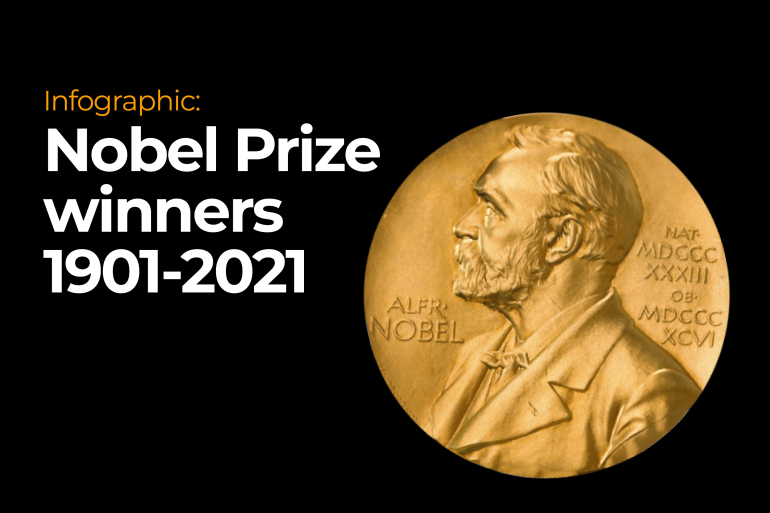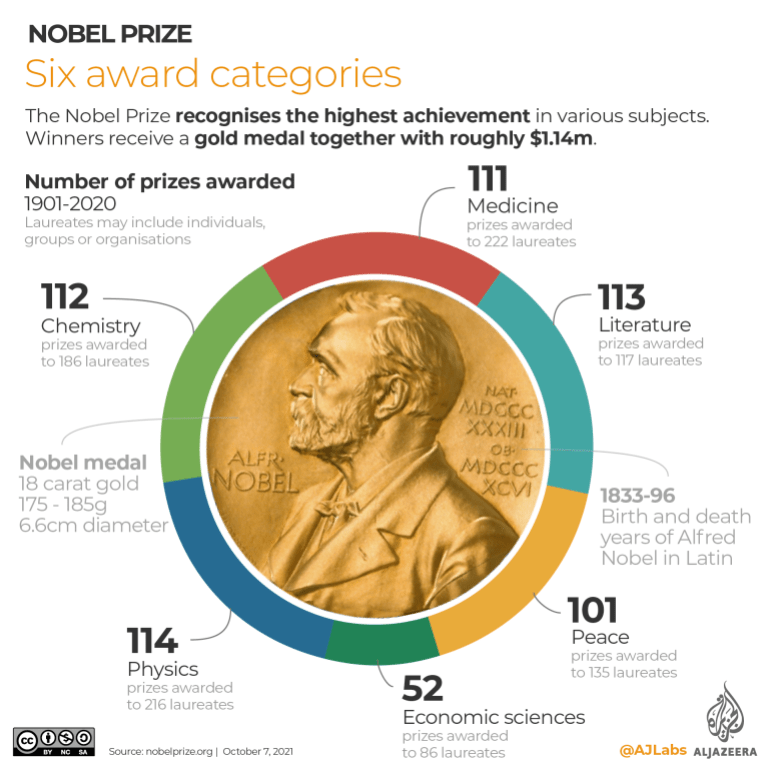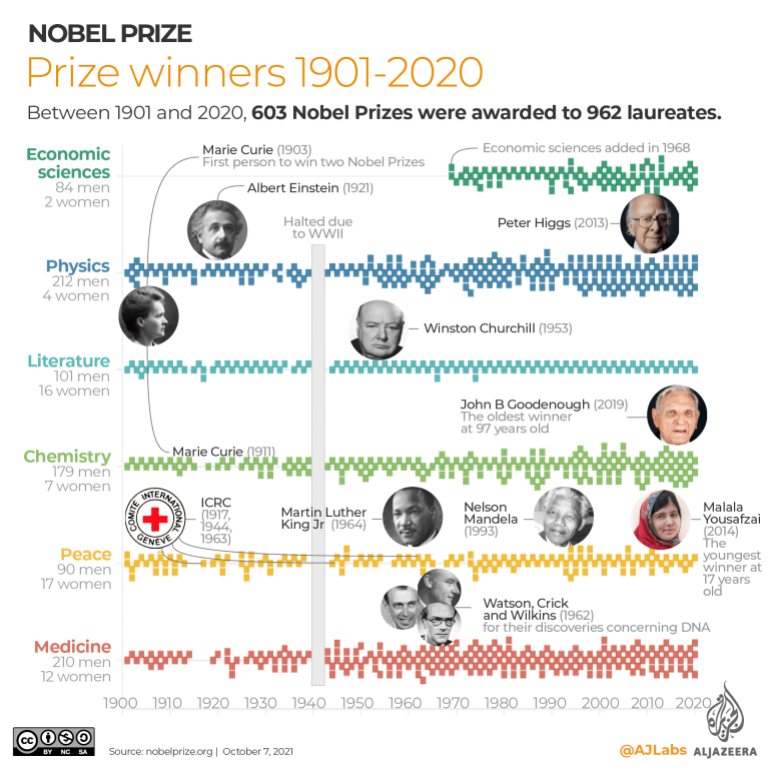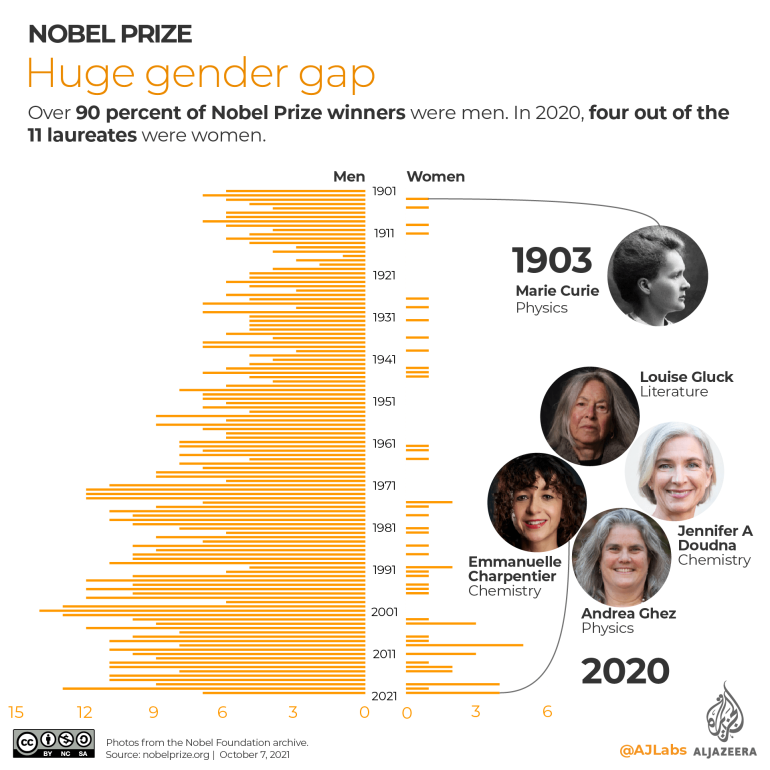Infographic: Nobel Prize winners 1901-2021
With the Nobel season in full swing, here are four graphics explaining some of the world’s most coveted awards.

Tanzanian author Abdulrazak Gurnah is the latest recipient of a Nobel Prize. On Thursday, the Swedish Academy announced Gurnah the winner of the top prize in literature for his “uncompromising and compassionate penetration of the effects of colonialism and the fate of the refugee in the gulf between cultures and continents”.
The 2021 Nobel season continues, with the announcement of the much-anticipated peace prize going to happen on Friday, followed by the economics prize on Monday.
Keep reading
list of 4 itemsMapping Israel-Lebanon cross-border attacks
Eid Mubarak: Hear greetings in different languages
When is Eid al-Fitr 2024 and how is it celebrated?
So far, eight men have won this year’s prestigious prizes in medicine, physics, chemistry and literature.
Six award categories
The Nobel Prize recognises the highest achievement in medicine, physics, chemistry, literature, peace and economic sciences. The Nobel Prize winners, often referred to as Nobel laureates, can be individuals, groups or organisations.
The Nobel Prize has been running since 1901, five years after the death of Alfred Nobel, a Swedish chemist and inventor of dynamite. Nobel left one of the world’s largest private fortunes to fund the awards.
In addition to the prestigious title, winners receive an 18-carat gold medal as well as a monetary prize which increased from roughly $1m in 2020 to $1.1m this year.
Five of the awards are announced from various institutes and academies across Sweden while the Nobel Peace Prize is announced from the Norwegian Nobel Institute in Oslo, the capital of Norway.

Notable winners 1901-2020
Between 1901 and 2020, 603 Nobel Prizes were awarded to 962 laureates.
Marie Curie, the Polish-French physicist, was the first person to win two Nobel Prizes – in 1903 and 1911 – for her work in the advancement in physics and chemistry.
In 2014, at 17 years, Malala Yousefzai became the youngest person to receive a Nobel Prize. She shared the peace prize with Kailash Satyarthi for their “struggle against the suppression of children and young people and for the right of all children to education”.
Some other notable Nobel laureates include Albert Einstein (1921, physics), Martin Luther King Jr (1964, peace) and Nelson Mandela (1993, peace).

Winners by continent
While the Nobel Prize is a global award, just more than half of all prize winners are from Europe. The United States has the highest number of Nobel laureates, at 281, as of 2020.
After Europe and North America, Asia has the third-highest number of Nobel laureates at 72, followed by Africa (27), Oceania (15), and South America (11).

Huge gender gap
More than 90 percent of Nobel Prize winners have been men. In 2020, four out of the 11 Nobel laureates were women.
Speaking to Al Jazeera, Lars Brink, the former chairman of the Nobel Committee for Physics, said there is a time lag between when the scientists performed their discoveries and when the Nobel Prizes are awarded.
In the case of physics, he said, many of the Nobel laureates’ discoveries were from the 1960s through to the 1980s, when there were very few female professors. “It’s going to be much better,” he added, but more time is needed.

2021 winners
On Monday, US scientists David Julius and Ardem Patapoutian won the Nobel Prize in medicine for their discoveries on nerve receptors for temperature and touch.
The next day, US-Japanese scientist Syukuro Manabe, Klaus Hasselmann of Germany and Giorgio Parisi of Italy won the physics prize for climate models and the understanding of physical systems.
On Wednesday, scientists Benjamin List and David WC MacMillan were awarded the top prize in chemistry for developing a new type of catalyst to accelerate chemical reactions.
And on Thursday, Gurnah won the prize in literature for his work on the effects of colonialism and refugees.